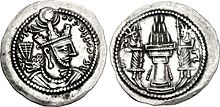Yazdegerd II
| Yazdegerd II | |
|---|---|
| "King of kings of Iran and Aniran" | |
 A coin of Yazdegerd II. | |
| Shahanshah of the Sasanian Empire | |
| Reign | 438–457 |
| Predecessor | Bahram V |
| Successor | Hormizd III |
| Born | Unknown |
| Died | 457 |
| Consort | Diang |
| Issue | Peroz I Hormizd III Zarir Balash |
| House | House of Sasan |
| Father | Bahram V |
| Mother | Sapinud |
| Religion | Zoroastrianism |
Yazdegerd II (Template:Lang-pal Yazdākird, meaning "made by God"; Persian: یزدگرد), was the sixteenth Sasanian emperor of Iran. He was the successor and son of Bahram V (420–438) and reigned from 438 to 457.[1] His name may also be spelled Yazdgard II.[2] His reign was marked by wars against the Byzantine Empire in the west and the Hephthalite Empire in the east, as well as by his efforts and attempts to impose Zoroastrianism on the largest religious minority within the empire, namely the Christians.
Reign
At the start of his reign, he continued his father’s policies. However, after some time, he turned away from these and started a policy of his own. When the Sasanian nobles told him that his new policies had offended the civilians, he said the following: "It is not correct for you to presume that the ways in which my father behaved towards you, maintaining you close to him, and bestowing upon you all that bounty, are incumbent upon all the kings that come after him ... each age has its own customs."[3]
Wars
In 440, Yazdegerd II waged a war against the Roman Empire, with little success for either side. The Romans, however, were invaded in their southern provinces by the Vandals, Making the Roman Emperor, Theodosius II (408–450), ask for peace and send his commander, Anatolius, personally to Yazdegerd's camp. In the ensuing negotiations in 440, both empires promised not to build any new fortifications in Mesopotamia and that the Sasanian Empire would get some payment.[4] Shortly after his peace treaty with Romans, he, along with Izad Gushnasp, Ashtat, and his vizier Mihr Narseh, moved towards Sasanian Armenia, and defeated the Armenians and captured many Armenian nobles, priests, and troops, sending them to the eastern Sasanian provinces to protect the borders from Hunnic invasions.
In 453, Yazdegerd II moved his court to Nishapur in Khorasan to face the threat from the "Huns" and left Mihr Narseh in charge of the Sasanian Empire. He spent many years at war against the Huns.[5] According to the Šahrestānīhā ī Ērānšahr, Yazdegerd fortified the city of Damghan and turned it into a strong border post against the Huns.[6] After his wars against the Huns, Yazdegerd's shifted his focus on Armenia, Caucasian Albania and the Roman Empire.[7]
Yazdegerd was known for his religious zeal in promoting Zoroastrianism, leading to persecutions of Christians, mostly Assyrians, and, to a lesser extent, Jews. Under his reign, 153,000 Assyrians were allegedly massacred solely in one city, Kirkuk.[8] According to Jewish chronicles, persecution against the Jews of Persia began in earnest in 456, reaching a degree of severity that they "prayed for mercy."[9] He is said to have issued decrees prohibiting Jews from observing the Sabbath openly and publicly, and ordered executions of a few Jewish leaders, which resulted in the Jewish community of Isfahan publicly retaliating by flaying two Zoroastrian priests while they were alive, leading to more persecutions against the Jews. Advancing his pro-Zoroastrian policy, he battled an uprising of Armenian Christians in the Battle of Avarayr in 451 and attempted to impose Zoroastrianism in Armenia.[10]
In his later years, Yazdegerd became engaged again with the Kidarites until his death in 457. According to a geonic source, Yazdegerd II was "swallowed by a serpent in his bedroom, and the persecution was annulled," said to be a veiled allusion to a successful conspiracy that resulted in the king's assassination.[11] The fight over the succession resulted in the annulment of the king's harsh decrees. According to Priscus, the Sasanian Empire was forced to pay tribute to the Kidarites, until the rule of Yazdgird II, who refused payment.[12]
He pursued strict religious policies and persecuted various minorities.
See also
References
- ^ S. Wise Bauer, The History of the Medieval World, (W.W.Norton Company Inc., 2010), 122.
- ^ H.A. Drake (5 December 2016). Violence in Late Antiquity: Perceptions and Practices. Taylor & Francis. p. 96. ISBN 978-1-351-87574-5.
- ^ Pourshariati (2008), pp. 70
- ^ "Yazdegerd II" at Encyclopædia Iranica
- ^ "Yazdegerd II" at Encyclopædia Iranica
- ^ "Yazdegerd II" at Encyclopædia Iranica
- ^ Touraj Daryaee, 23.
- ^ Certrez, Donabed, and Makko (2012). The Assyrian Heritage: Threads of Continuity and Influence. Uppsala University. pp. 258–259. ISBN 978-91-554-8303-6.
{{cite book}}: CS1 maint: multiple names: authors list (link) - ^ The Iggeres of Rav Sherira Gaon (ed. Nosson Dovid Rabinowich), Jerusalem 1988, p. 117
- ^ "Yazdegerd II" at Encyclopædia Iranica
- ^ The Iggeres of Rav Sherira Gaon (ed. Nosson Dovid Rabinowich), Jerusalem 1988, p. 117; Zev Yavetz, Toldot Israel (History of Israel), vol. 8, Berlin 1912, p. 144.
- ^ The Cambridge Companion to the Age of Attila, Michael Maas p.287
Sources
- Pourshariati, Parvaneh (2008). Decline and Fall of the Sasanian Empire: The Sasanian-Parthian Confederacy and the Arab Conquest of Iran. London and New York: I.B. Tauris. ISBN 978-1-84511-645-3.
{{cite book}}: Invalid|ref=harv(help) - Shapur Shahbazi, A. (2005). "SASANIAN DYNASTY". Encyclopaedia Iranica, Online Edition. Retrieved 30 March 2014.
{{cite encyclopedia}}: Invalid|ref=harv(help)
